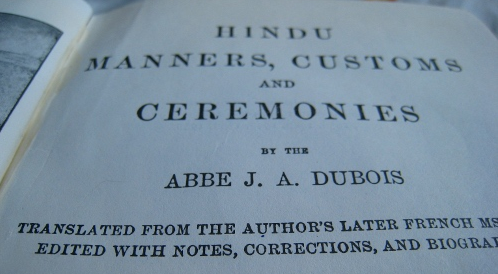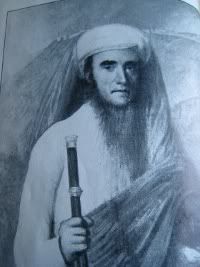
The discovery of skeletons in Mohenjo-daro in 1920s led Sir Mortimer Wheeler to opine that Harappa was overthrown by invaders, inspired by the Vedic god Indra.[1] Now archaeology and genetic studies have discredited Sir Mortimer Wheeler’s Aryan invasion theory, which originated in the twentieth century. The external origins of Aryans is now being kept alive by “sporadic migration and occasional contacts” theory[2]. But much before the Aryan invasion theory, there used to be a migration theory of Biblical proportions[3] whose originator was Jean-Antoine Dubois, a French-Catholic missionary, who spent time in Pondicherry, Madras Presidency and Mysore from 1792 to 1823.
The French revolution started in 1789 and Dubois fled in 1792 at the age of 27, which turned to be a wise decision, for if he had stayed back he would have been killed. In India he adopted the local dress and habits like the Tuscan Jesuit missionary Roberto de Nobili, the Roman Brahmin, who did this almost two centuries before Dubois. This technique worked well, for he was welcomed by people of all castes.
In 1799, when Seringapatam fell, Richard Colley Wesley who was the Governor General of India, invited Dubois to organize the Christian community of Mysore which had been forcibly converted to Islam by Tippu Sultan; he reconverted 1800 people.
His greatest accomplishment was writing a book — Hindu Manners, Customs and Ceremonies — based on his experience, important books and various records he obtained. It is in this book that he came up with his theory for the origins of the Brahmins.
He was aware that Hindus claimed Brahmins originated from Brahma’s head and that they were from near Maha-Meru and Madara Parvata. He was aware of the concept of the seven rishis, recognized in the Great Bear and the flood story in Indian mythology.
 For Dubois, these Hindu fables were absurd. Before presenting his theory, he first dismissed two other ideas. The first one claimed that Egyptian king Sesostris conquered land till the Ganges; the second, that the caste system was obtained from the Arabs.
For Dubois, these Hindu fables were absurd. Before presenting his theory, he first dismissed two other ideas. The first one claimed that Egyptian king Sesostris conquered land till the Ganges; the second, that the caste system was obtained from the Arabs.
Once these were out of the way, Dubois presented his thesis. After the flood, the whole world was repopulated again. For this, Noah and his sons dispersed around the world. One group went West, while the others under the guidance of Magog, Noah’s grandson, went to the Caucasian range. From there they came via the North into India and populated it. He even has a date for this migration – nine centuries before Christian era. Thus the Brahmins, according to Dubois, were descendants of Magog’s father Japheth.
By the time Dubois wrote his manuscript, comparative linguistics had just arrived on the scene in a big way. In 1786, Sir William Jones published his The Sanscrit Language in which he observed that Sanskrit resembled Greek and Latin and suggested a common source, which would be called proto-Indo-European. Dubois decided to dabble in a bit of linguistics himself.
For Dubois, Magog and Gotama sounded the same. He suspected that they were the same person. He also found similarities between Prometheus and Brahma (say Brema and Prome aloud few times and you will get it. Or may be not). If you think that this Brahma = Prometheus thing does not add up, here is the clincher. Like how Prometheus asked Hercules for help, Brahma also asked Vishnu for help, not once, but many times. As I found myself nodding in agreement, he ruined it for me with the statement that Prometheus could be Magog himself.
With our current understanding it is easy to dismiss the work as fanciful narrative, but in the 19th century it was taken seriously; Dubois’ work was influential. He gave the French manuscript to Mark Wilks, the British Resident of Mysore, who in turn sent it to the Madras government. In 1816, it was translated to English. The prefatory note to the English edition was by none other than F. Max Muller, who wrote that Dubois, though a missionary, was free from theological prejudices. Lord William Bentinck, who would later become the Governor General and would play a part in Macaulay’s education in India, recommended the book highly. Bentinck praised the book saying that it would help the East India Company employees a great deal in their conduct with the natives. The East India company paid 2000 star pagodas for the manuscript.
While everyone — Wilks, Bentick, Muller — praised the book for the observations on the caste system, no one found the Biblical connection objectionable. Even preface to the 1906 edition which I read did not question it. Thus Indian history of the 19th century combined Sir William Jones’ comparative linguistics, Dubois’ Biblical Migration theory and Max Muller’s arbitrary dating of the Vedas. The impact of Sir William Jones and Max Muller are still present in the same form, while Dubois’ migration theory is present in a modified version.
The path taken by Indo-Europeans of the Aryan Migration Theory 2.0 is the same as that proposed by Dubois: from the Caucasus to India. A group of Indo-Europeans would go West, like Noah’s sons, to be the Mittani.[1]
Though he came to covert, by his own account, Dubois was not a successful missionary[4].

Dubois later wrote a controversial pamphlet — Letters on the state of Christianity in India — in which he declared that it is next to impossible to convert Indians. He went back to Paris on Jan 15, 1823, never to return again. He kept a low profile and Max Muller who visited Paris in 1846 did not know that Dubois was well and alive at that time. Dubois died two years later.
Postscript: Dubois was paid well and he lived off the money for some time. There is a controversy that the original manuscript was not written by Dubois, but was based on something written by Pere Coeurdoux in 1760s[5].
References:
- The Wonder That Was India by A L Basham
- Indo-Aryan Controversy: Evidence and Inference in Indian History; By Edwin Bryant, Laurie L. Patton
- A Survey of Hinduism by Klaus Klostermaier
- Debate Transactions of the Royal Historical Society By Royal Historical Society
- Castes of Mind: Colonialism and the Making of Modern India. By Nicholas B. Dirks
- Hindu Manners, Customs and Ceremonies by Abbe J. A. Dubois


 For Dubois, these Hindu fables were absurd. Before presenting his theory, he first dismissed two other ideas. The first one claimed that Egyptian king Sesostris conquered land till the Ganges; the second, that the caste system was obtained from the Arabs.
For Dubois, these Hindu fables were absurd. Before presenting his theory, he first dismissed two other ideas. The first one claimed that Egyptian king Sesostris conquered land till the Ganges; the second, that the caste system was obtained from the Arabs.

